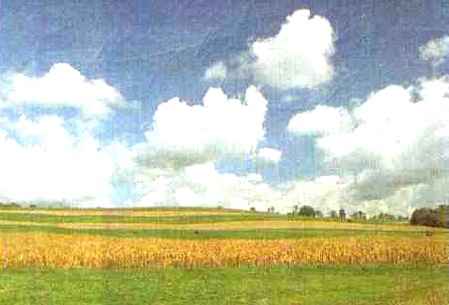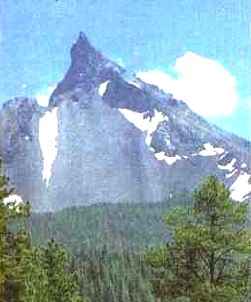The "calm" life of the earth's stone shell ends as soon as it comes into contact with water or gases. Then on earth surface amazing transformations take place and phenomena are observed that simply cannot arise in the deep depths.
The relief of the Earth is a combination of various surface irregularities, both large and small, resulting from the activity of external and internal forces. An important role in the formation of the relief is played by the force of gravity, density and composition of rocks, activity and flowing waters. The formidable forces of nature, setting in motion the strongest rock massifs, both destroy them to the ground, and create new mountains, hollows, gorges and valleys. Even at the bottom of the oceans, huge plains appear, which over time are covered with silt and large debris. This is happening rather slowly, and the whole human life is not enough to notice changes in the surface. It seems to be breathing - it rises, then falls, waves run over it, it bursts from the tensions that have arisen.
On the surface of the planet, water circulates (from to land and further to), air masses, the change of vegetation and the migration of animals, the movement of large debris and the smallest ached. Scientists consider all this to be a process of exchange of matter and energy, which leads to the formation of loose sediments, and at the same time to the formation, that is, to the process of morpholithogenesis. Even if a few grains of sand are moved by the wind or water a short distance, a small hole or bump will appear on the surface. However, morpholithogenetic analysis reveals only part of the connections between the relief, atmosphere, and natural waters. Morphostructural analysis shows another part of the connections.
Morphosphates are called geological structures, expressed in modern relief. The largest morphostructures on Earth are. They belong to planetary morphostructures, within which there are mountain belts, plateaus and plains, underwater ridges and basins, differing in structure crust, the type and speed of tectonic movements, the degree of participation of other factors in their formation. Thus, planetary morphostructures are composed of smaller regional morphostructures.
The relief of large regions has been forming for many millions of years. In places of ancient platforms, a crystalline basement, composed of gneisses, granites, shales and sandstones, usually comes to the surface. Such a foundation serves as a base for the relief, a plinth, and, composed of these rocks, are called basement plains. In Russia, they can be found in, on, in the north of Siberia.
Plains on ancient platforms and shields appeared hundreds of millions of years ago. The basement plains, for example, belong to the Paleozoic period. The planetary relief is closely related to the largest morphostructures of the Earth.
Regional morphostructures arose somewhat later than planetary ones. Tectonic movements took part in their development, and against their background, the processes of crushing of rocks, movement of the upper ones, etc. took place.
The analysis is used in the study of large landforms, composed of different rocks; tectonic movements that led to the emergence of large landforms; discontinuities - faults limiting morphostructures.
If we talk about the age of the relief of large mountain belts, then it is obvious that their age is not less than 200 million years; if it comes to, for example, age Caucasus mountains, then it will be 80 - 90 million years. In both cases, to determine the age of the relief, it is necessary to know the beginning of the appearance of its largest and most characteristic forms. In mountainous areas, this is the formation of not only ridges, but also intermontane depressions. Often, to determine the time of the beginning of the division of the relief into hills and hills, mountains and depressions, the age of one of the ancient alignment surfaces is taken as the starting point of reference. This is the name of the undulating plain, weakly dissected by erosion, which existed in the past on many continents.
The beginning of the erosional division of the plain is the starting point for determining the age of the relief.
Relief age- the time that has passed since the formation of its modern appearance. It is measured on a single time scale - in years, hundreds, thousands, millions of years, although time ranges are often used, calling the relief Mesozoic, Neogene Quaternary, Late Pleistocene, etc.
Formation of the Earth's relief
Features of the Earth's relief
- What are the main surface shapes on land and ocean floor. How do they differ in height and are depicted on the map?
- How do mountains and plains change over time?
Huge expanses of land and ocean depressions, their vast plains and mountain ranges, majestic cones of volcanoes, deep gorges, hills, ravines form an extraordinary variety of surfaces on Earth. The set of irregularities of the earth's surface, differing in size, origin and age, is called a relief.
The relief has a significant impact on the formation, development and placement of all components of nature. Knowledge about the relief will help you better understand the features of the nature of continents and oceans, their large parts, the nature of individual countries.
The interaction of internal and external forces is the main reason for the variety of relief. The relief of the Earth is constantly changing as a result of the simultaneous influence of internal and external forces on it. Internal forces are manifested in the processes of movement of the lithosphere, the introduction of material from the mantle into the earth's crust or its outpouring onto the surface of the Earth. The action of these forces is caused by the movement of matter throughout the mantle. The movements of the lithosphere move rock layers, change the structure of the earth's crust, and hence its relief. Distinguish between slow vertical movements, which occur everywhere, and horizontal movements, the most significant of which is the movement of lithospheric plates. As a result of their movement, the largest forms of relief are formed - protrusions of continents and depressions of the oceans, mountain belts, huge plains.
Rice. 12. Modern volcanoes are located along large faults in the lithosphere. What changes occur in the geospheres during volcanic eruptions?
External forces act on the surface of the Earth. They receive their energy from the Sun, as well as from the force of gravity and the vital activity of organisms. External forces are weathering, the work of flowing waters, wind, groundwater, glaciers, sea surf, human activity. These forces destroy rocks and carry the products of destruction from one, higher, sections of the earth's surface to others, where they are deposited and accumulate loose material. Weathering plays an especially important role in the destruction and leveling of the relief on land.
Internal and external forces act simultaneously. At the same time, internal forces mainly create large forms of relief, external forces mainly destroy them, and their creative power manifests itself in the formation of small-sized relief forms. On the plains, these are hills, river valleys, ravines, talus in the mountains, small ridges, gorges, rocks of bizarre outlines, etc. The relief of the Earth is changing continuously. The outlines of mountains, their heights are changing, the hills are leveled, even, albeit very slowly, the outlines of the continents are changing.

Rice. 13. Endless expanses of the East European Plain
Between the protrusions of the continents and the ocean depressions separating them, there are transition areas, which include a continental shelf (shelf) with a relatively flat relief and a continental slope cut by gorges.
In terms of the variety of relief, the ocean floor is in no way inferior to the land surface. The feature of the ocean floor relief is a single system of mid-oceanic ridges, the total length of which is over 60 thousand km. On the outskirts of the oceans, there are deep-sea depressions that are not found on land. The areas of the ocean floor between the continental foot and the middle ridges are flat, with gentle hills. These are oceanic plains.

Rice. 14. Bizarre outlines of the Rocky Mountains in North America
Placement of large landforms on the surface of the Earth. There are certain patterns in this placement. The protrusions of the continents correspond to the continental crust, and in the areas of the distribution of the oceanic crust there are depressions filled with ocean water. Great plains correspond to ancient sites of lithospheric plates - platforms. Mountain folded areas, deep-sea trenches on the ocean floor are located at the boundaries of the lithosphere plates.
- What is relief? What are the reasons for its diversity?
- Consider whether it can be argued that external and internal forces act in the same way on land and at the bottom of the ocean. Explain why.
- Give examples that support the patterns outlined in the text.
They change quite quickly (a small ravine can appear in a few months), larger forms change slowly, over the centuries. However, there are factors (such as landslides) that can change the topography in a few hours: mountains appear, crevasses, river directions change. In the summer of 2007, one of such events took place: a landslide destroyed a unique geographic formation, the valley of geysers.
The relief changes under the influence of two types of factors: exogenous and endogenous. Endogenous (internal) factors: movements of the earth's crust, volcanic eruptions are discussed in detail in the relevant sections. Exogenous factors include: the destructive activity of wind and water, heat, animal and flora.
Water has a serious impact on the relief. It erodes rocks, forming ravines, washing away entire hills, washes away rocks, which can then collapse. Rivers can become more full-flowing and lay a new channel, or they can become shallow, and then land areas remain in place of water. All these are relief changes. In addition, water interacts with rock materials, changing their composition and structure, which can lead to changes in the relief.
The wind acts especially actively where there are no dense growth of plants. The wind blows out small particles of rocks and brings them to other areas, where they are deposited, trapped by water or plants.
Many rocks are destroyed by heat. Either heating up, then cooling back, they constantly expand and contract again. This leads to the destruction of bonds between the molecules of the substance, the rocks crack.
Plants and animals also affect the formation of relief, some more, others less. Plant roots destroy dense rocks and at the same time strengthen looser ones. Microorganisms change the structure of the soil, which can also lead to a change in the relief. Animals that build dams on rivers and streams, in particular, beavers, have a huge impact on the relief.
Basic landforms
- Plains are flat or hilly areas of land that have a fairly large area. Plains differ in absolute height (above sea level):
- Lowlands, the height does not exceed 200 m.
- Uplands, height from 200 to 500 m.
- Plateau, height over 500 m.
- Plateau is a specific landform with a flat top and steep edges, absolute height can reach 3 km.
Plains- more stable areas of the earth's surface, they are less likely, flat rivers are calmer, the relief changes much more slowly.
The mountains- land areas that rise to a height of more than 500 m, with a certain peak and steep slopes.
Mountains can form ridges and highlands. The ridge is a group of mountains, obviously elongated in a certain direction and having a slight difference in elevation. Famous mountain ranges.
The largest (planetary) landforms correspond to the largest structural elements of the earth's crust. Their morphological differences are determined by differences in the structure and history of individual sections of the earth's crust, as well as by the direction of tectonic movements. These subdivisions of the relief of the earth's surface, in the formation of which the leading role belongs to internal processes, are called morphostructures.
Morphostructures of a planetary scale are subdivided into morphostructures of a smaller order - individual hills, ridges, massifs, plateaus, depressions and others, which are still relatively large relief forms. They are superimposed on smaller various forms, the so-called morphosculpture, formed mainly under the influence of external forces of the Earth, fed by the energy of the Sun.
> Morphostructures.
The largest irregularities of the Earth's surface form the protrusions of the continents (land together with the shelf) and the depressions of the oceans. The largest land relief elements are flat-platform and mountain (orogenic) areas.
Plain-platform areas include flat parts of ancient and young platforms and occupy about 64% of the land area. Primary flat surfaces, formed by almost horizontally lying sedimentary rock strata, prevail. Symmetry is observed in the placement of these areas: they are confined to two latitudinal belts, one of which is located in the North, and the other - in Southern hemisphere... In the Northern Hemisphere there are the North American, East European and Siberian Plains, in the South - South American (Brazilian), African-Arabian and Australian. Within the platform plains, there are separate lowlands and uplands, plateaus, plateaus and high-rise massifs (Zhigulevskie mountains on the East European Plain, Putorana mountains on the Central Siberian plateau, mountain range Ahaggar on the African-Arabian platform plain. In general, the amplitude of the heights of the surface of the platform plains is 10--20 times less than in mountainous countries.
Among the flat-platform areas there are low, with absolute heights of 100-300 m (East European, West Siberian, Turaiskaya, North American), and high, elevated the latest movements crust to a height of 400-1000 m (Central Siberian Plateau, African-Arabian, Hindustan, significant parts of the Australian and South American Plains). Plains of the second type prevail in the land relief. The morphological appearance of the low and high plains is sharply different. The high plains, in contrast to the low ones, are characterized by a great depth of dissection, a stepped surface, mainly due to displacements along faults, and in some places - manifestations of volcanism.
Distinguish between ancient platform plains, formed on the Precambrian platforms (for example, the East European), and young - on young platforms (for example, West Siberian) - more mobile than the first.
Mountain (orogenic) areas occupy about 36% of the land area. Within their limits, mountain structures of two types are distinguished: young, or epigeosynclinal, which arose for the first time in the orogenic stage of development of the geosynclinal systems of the Cenozoic (mountains of southern Eurasia, western North and South America), and revived mountains, or epiplatform mountains, which formed on the site of ancient flattened or dilapidated folded areas of various ages as a result of rejuvenation and revival by the latest movements of the earth's crust (for example, Tien Shan, Kunlun, mountains of South Siberia and Northern Mongolia in Asia, Rocky Mountains in North America, the highlands of East Africa, etc.). Revived mountains prevail in area over young ones, which is associated with the huge spread of epiplatform orogenesis at the neotectonic stage of the development of the earth's crust (Neogene - Anthropogen). From the era preceding the newest mountain building, uplifted areas of ancient flattening surfaces are preserved in mountains of this type. Unlike young mountains, they are characterized by a discrepancy between the orographic plan, the structure of the hydraulic network and the geological structure.
The ocean floor is subdivided into the underwater margin of the continents, the zone of island arcs, or transition zone, the ocean floor and mid-ocean ridges.
Submarine outskirts of the mainland(about 14% of the Earth's surface) includes a shallow-water flat strip of the continental shelf (shelf), a continental slope and a continental foot located at depths from 2500 to 6000 m. The continental slope and the continental foot separate the protrusions of the continents, formed by the combination of land and shelf, from the main part of the ocean floor, called the ocean floor.
Zone of island arcs. Ocean bed not in all areas the globe directly bordered by the continental foot. On the western outskirts of the geosynclinal regime that have survived to this day The Pacific, in the area of the Malay Archipelago, Antilles, the Scotia Sea and in some other areas between the continent and the ocean floor there is a transition zone, which is distinguished by a significant width and a sharp change in raised and deeply lowered sections of the bottom. In these areas, archipelagos of island arcs, depressions of the marginal seas (for example, the Bering, Okhotsk, etc.), mountains and uplifts within them, as well as deep-water trenches, are distinguished. Island arcs are young mountain structures protruding above the water in the form of a chain of islands (Kuril, Sunda, Antilles, etc.); deep-sea trenches - long and narrow depressions of the ocean floor, bordering island arcs from the ocean side and submerged to a depth of 7-11 km. Some island arcs consist of two parallel ridges (for example, the Kuril Arc) or are replaced by a chain of young mountains located along the outskirts of the mainland (for example, the Cordillera on the Pacific coast of America). In the zone of island arcs, the greatest relief contrast on Earth is observed.
The ocean floor itself (about 40% of the Earth's surface) is mostly occupied by deep-water (average depth of 3-4 thousand m) plains, which correspond to oceanic platforms (thalassocratons). There are flat (sub-horizontal), inclined and hilly plains with fluctuations in heights (for the latter) up to 1000 m. The plains form the bottom of separate basins, which are separated in the sub-latitudinal and sub-meridional directions by underwater heights, ramparts and ridges. Numerous isolated seamounts (volcanoes) rise among the flat spaces of the ocean floor, some of which have flattened peaks (guyots).
The largest element of the underwater relief is the mid-ocean ridges (about 10% of the Earth's surface). Their total length is over 60 thousand km. They are gentle, swell-like uplifts from several tens to 1000 km wide, rising 2--3 km above the bottom of neighboring basins. Individual peaks of the ranges rise above sea level in the form of volcanic islands (Tristan da Cunha, Bouvet, St. Helena, etc.). Some links of the mid-ridge system are distinguished by a lower relative height (low mid-ocean ridges), the absence of rift disturbances, and less dissection.
Each of the middle ridges has its continuation in the area of the continental crust: rift disturbances of the East Pacific Rise are traced in the structures of the California coast of the United States, disturbances of the Central Indian Ridge - in the graben-rifts of the Gulf of Aden, the Red Sea and in the faults of East Africa, disturbances of the Mid-Atlantic ridge - on the island of Svalbard. In the structure of the Earth's surface, deep faults play a huge role, cutting through the entire earth's crust and often going into the mantle. They divide the bark into separate blocks, well expressed in relief. In particular, they are associated with rectilinear sections in the outlines of the continents. At the bottom of the oceans, the largest faults stretch for thousands of kilometers in latitudinal and sublatitudinal directions and are expressed in relief in the form of scarps, narrow depressions and ridges rising above them. These faults cross the mid-ocean ridges, breaking them into separate segments, shifted from one another by tens and hundreds of kilometers.
> Morphosculptures.
The greatest role in the formation of morphosculptures is played by the work of rivers and time streams. They create widespread fluvial (erosional and accumulative) forms (river valleys, gullies, ravines, etc.). Glacial forms are widespread, due to the activity of modern and ancient glaciers, especially of the cover type (the northern part of Eurasia and North America). They are represented by valleys-troughs, "ram's foreheads" and "curly" rocks, moraine ridges, lakes, etc. On the vast territories of Asia and North America, where permafrost strata are widespread, various forms of permafrost (cryogenic) relief are developed. The desert and semi-desert regions are characterized by the so-called. arid forms, in the creation of which intense physical weathering, wind and time currents play a decisive role.
External processes on land are largely due to the climatic features of the terrain, and therefore the distribution areas of morphosculptures of a certain type are distributed over the Earth's surface quite regularly.
At the bottom of the oceans, morphosculptures are formed under the influence of coastal abrasion-accumulative processes, the activity of turbidity (suspension) flows, the impact of bottom currents, etc.
Relief is called general form the earth's surface. The relief is constantly changing, smaller forms of relief change quite quickly (a small ravine can appear in a few months), larger forms change slowly over centuries. However, there are factors (such as earthquakes, volcanic eruptions, landslides) that can change the relief in a few hours: mountains appear, crevasses, river directions change. In the summer of 2007, one of such events took place in Kamchatka: a landslide destroyed a unique geographic formation, the valley of geysers. The relief changes under the influence of two types of factors: exogenous and endogenous. Endogenous (internal) factors: movements of the earth's crust, volcanic eruptions are discussed in detail in the relevant sections. Exogenous factors include: the destructive activity of wind and water, heat, flora and fauna. Water has a serious impact on the relief. It erodes rocks, forming ravines, washing away entire hills, washes away rocks, which can then collapse. Rivers can become more full-flowing and lay a new channel, or they can become shallow, and then land areas remain in place of water. All these are relief changes. In addition, water interacts with rock materials, changing their composition and structure, which can lead to changes in the relief. The wind acts especially actively where there are no dense growth of plants. The wind blows out small particles of rocks and brings them to other areas, where they are deposited, trapped by water or plants. Many rocks are destroyed by heat. Either heating up, then cooling back, they constantly expand and contract again. This leads to the destruction of bonds between the molecules of the substance, the rocks crack. Plants and animals also affect the formation of relief, some more, others less. Plant roots destroy dense rocks and at the same time strengthen looser ones. Microorganisms change the structure of the soil, which can also lead to a change in the relief. Animals that build dams on rivers and streams, in particular, beavers, have a huge impact on the relief. The main landforms Plains are flat or hilly areas of land that have a fairly large area. Plains differ in absolute height (above sea level): Lowlands, the height does not exceed 200 m. Uplands, the height is from 200 to 500 m. The plateau, the height is more than 500 m. The plateau is a specific form of relief, which has a flat top and steep edges, absolute height can reach 3 km. Plains are more stable areas of the earth's surface, they are less likely to have earthquakes, plain rivers are calmer, and the relief changes much more slowly. Mountains - areas of land that rise to a height of more than 500 m, with a certain peak and steep slopes. Mountains can form ridges and highlands. The ridge is a group of mountains, obviously elongated in a certain direction and having a slight difference in elevation. Famous mountain ranges: Himalayan, Ural. A highland is a group of mountains that includes mountain ranges, individual mountains, small valleys. Known highlands: Pamir, Tien Shan, Cordillera. The shelf is a landform characteristic only for the World Ocean. These are flat, extensive areas of the seabed, shallow and usually located along the coast.




